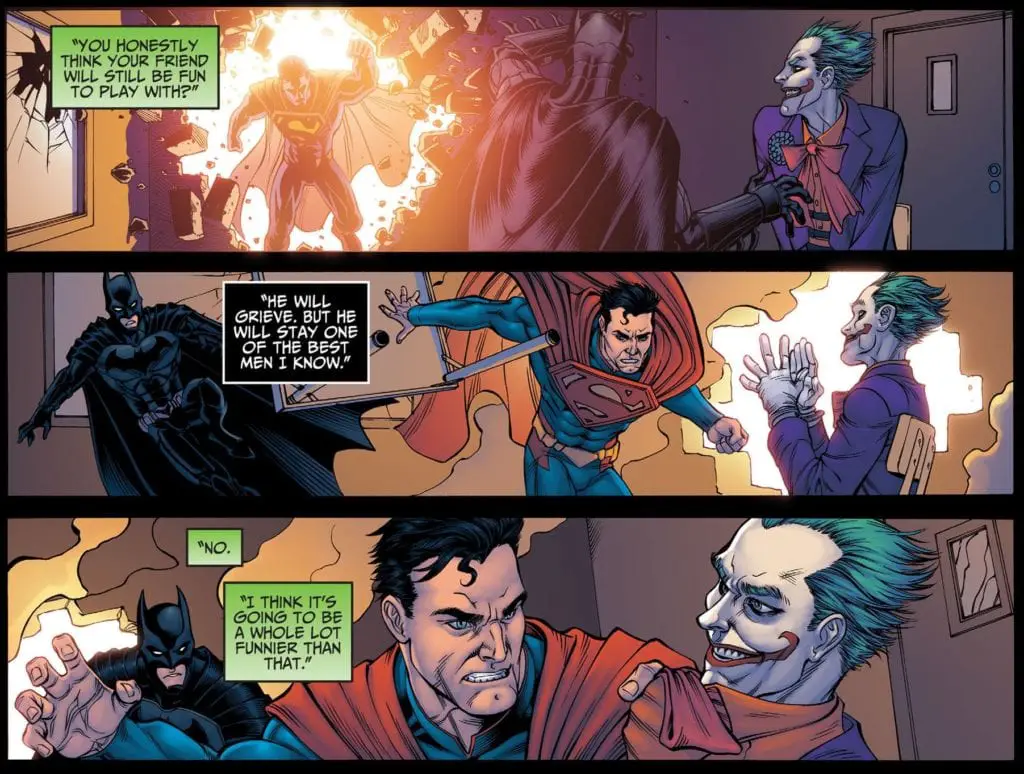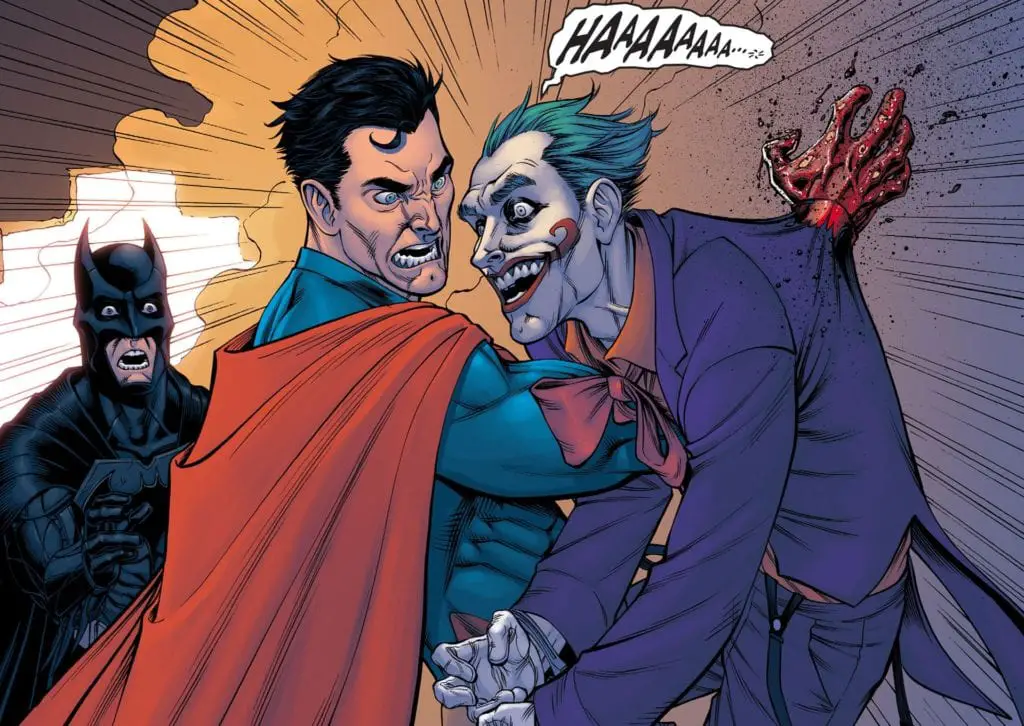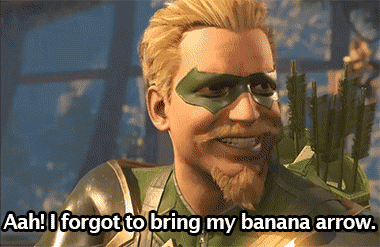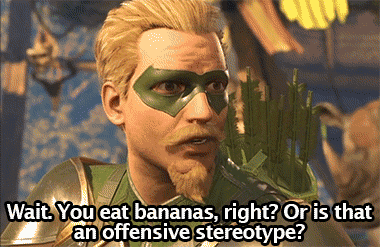Outside of Super Smash Bros, I’m really not big into fighting games. It’s not that I’m terrible at them (I like to think I’m half-way decent), but rather that there just wasn’t a whole lot that drew me into them. If I didn’t love the characters, that is.
Obviously, that means that the surprise 2013 hit Injustice: Gods Among Us was a welcome exception. It took some of the best ideas across DC’s modern era (the Justice Lords episode of Justice League, Kingdom Come, Red Son, Infinite Crisis, Tower of Babel, Crisis on Multiple Earths, etc) and linked them together to create a tale of an Alternate Earth where it took five minutes for the Chicago-based NetherRealm Studios to convince you that, yeah, Superman could go off the deep end if the following things happened:
- Joker gets bored of messing with Batman, so he moves to Metropolis
- Joker and Harley steal a submarine, murder Jimmy Olsen, and kidnap a pregnant Lois Lane
- Superman confronts the Mad Love duo and gets hit in the face with Kryptonite-laced Fear Toxin, making him think that Lois is actually Doomsday: the monster that killed him
- Superman drags Lois into space, intending to throw her into the sun…but realizes what’s happening mere seconds after she suffocates
- A nuclear warhead stolen from the submarine, which was set to trigger if Lois’s heart stopped, goes off in the center of Metropolis, vaporizing it
So, yeah. Clark lost his best pal, his wife, his city, and his unborn child to a maniac’s boredom. Why did the Joker do this? To prove the point he could never make with Batman: no one is incorruptible.
[tw_gallery type=”gallery,slider” height=”200″]
[/tw_gallery]
Yup. The Joker broke Superman. The actual game, which involves some inter-dimensional travel so the real heroes of the DCU can help take down the evil Superman, takes place five years after this moment. Five years that were phenomenally told in an ongoing digital-first comic written first by Tom Taylor (current author of the Injustice 2 comic that chronicles what happened between the first and second game) and completed by Brian Buccellato. It touched nearly every corner of the DCU, new and old, and showed Clark’s descent into tyranny in a way that, while not actually necessary to appreciate just how good the first Injustice was, truly made you understand the scope of it and the slope he kept slipping down. It reads like an epic, with each “year” of the story detailing a different aspect of the escalating conflict between Batman’s insurgency and Superman’s regime.
Also, if you’re a fan of Harely Quinn, you may be interested to know that it was basically this series that started explicitly spotlighting her being a survivor of abuse after the Joker’s murder. She quickly became an ally to Batman, member of the Birds of Prey (most of which are either dead or presumed dead at this point) and all-around unlikely hero.
Those pages and panels you’ve likely seen of Harley and Dinah—specifically the one where Dinah has morning sickness in the middle of a fight and they have a heart to heart, as well as Harely giving Dinah a muzzle for the newborn Connor in case he screams like her—circulating through social media these past few years were from Injustice, not the primary DCU. So, just something to think about.
Anyway, the first game was about what Batman v Superman: Dawn of Justice tried, and failed, to be about three years before that movie ever hit theaters. It ended with Superman in a prison cell and his regime being torn down. So, naturally, the sequel would have have a pretty damn good reason for getting him out of there.
Thankfully, they did. The answer turned out to be “let’s just steal CW’s Supergirl origin story and make it Brainiac that blew up Krypton!” And boy did it work.
I don’t want to spoil what goes down, but I’ll tell you that it’s extremely evocative and wonderfully told. The script is tight, sharp, intelligent and witty. There are a few strange inconsistencies with the prequel comic and the internal narrative of Injustice 2, yet just as many awesome continuity nods to the collective work of Taylor and Buccellato so…look, 99% chance you won’t even notice. Regardless, it gels together very nicely to form a conclusion that is, frankly, rather bold. It’s not quite as compelling as the original, but the way in which Injustice 2‘s story is presented elevates it to even ground.
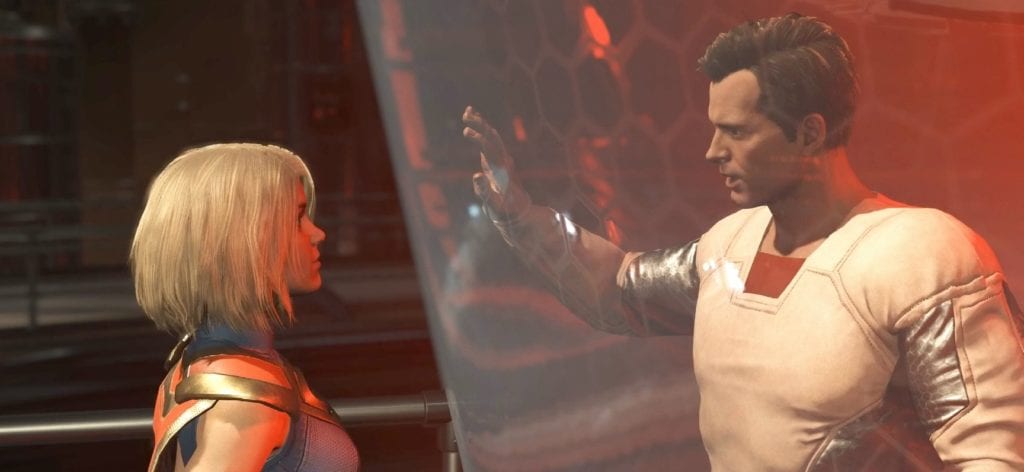
The narrative is pretty straightforward (assuming you’ve played the original Injustice), and definitely one of, if not the best, DC adaptations I’ve ever seen/played that isn’t the original DC Animated Universe. Of course, it helps that they got a big portion of the original voice talent from the Paul Dini/Bruce Timm era of DC Animation to feature in the game once again. Susan Eisenberg (Wonder Woman), Kevin Conroy (Batman, obviously) and George Newbern (Superman) all return to their roles with the same excellence they’ve had for the past fifteen years. Or, in Conroy’s case, twenty-five years. Khary Payton, the voice of Cyborg from the Teen Titans animated series, returns as well. Phil Lamarr even shows up to reprise his role as Green Lantern John Stewart in an optional reskin of Steven Blum’s rendition of Hal Jordan (repentance is a really good look on Hal, honestly), which is pretty cool. Even some of the Arkham voice talent joins in, with Grey DeLisle returning as Catwoman, Tasia Valenza as Poison Ivy, and Tara Strong as Harely Quinn.
Really, the entire cast is stellar, with Laura Bailey portraying a particularly standout Supergirl. The facial animation, though, that’s on a whole new level. If you thought The Witcher 3 had the best facial/animation tech in gaming, hooboy, you are in for a treat. Every piece of dialog is, well, acted. Even the intro banter for non-story fights! As in, we’re not in the uncanny valley, but the animation is so fluid and natural and expressive that it truly looks like actual actors just…playing those parts. Seriously, even if you take out the subtitles here, you can probably pick out what Green Arrow, voiced by the always amazing Alan Tudyk, is saying. That goes for every character, by the way! It’s just that enunciated!
[tw_gallery type=”gallery,slider” height=”200″]
[/tw_gallery]
But enough about how entertaining the story and characters are! What about the “game” part? Well, in a few words: it’s a ton of fun and looks gorgeous. I don’t have a PS4 Pro or a 4k TV—I’m more of a PC Gamer—but I never experienced a single technical issue or a noticeable frame drop. The bread and butter of the game, the actual fighting, is a slight riff off of the tried-and-true combo, grabs, throws, blocking, ducking and juggling based mechanics that made Mortal Kombat what it is today. Except now you can dodge-roll and air-escape at the cost of your Super Move meter! In addition to that meter-based cinematic Super Move, all of which can be blocked/cancelled in some way if you’re fast enough, each character also gets their own unique power which is activated by the circle button.
For example, I play a lot of Black Canary—like so much. So depending on how well I’m doing or how long I’ve been playing in a match, I can unleash a Canary Cry of three different levels. The first stuns at close range, the second does a bit more damage, and the third is a long-range blast of sonic energy that can knock an enemy off their feet. Some characters have multiple different powers attached to the button, depending on context and what your gear loadout (more on that later) is set as. If you’re playing as Wonder Woman, you gain one of five random stat boosts based on her patron gifts for a limited time. On the other hand, if you’re playing as Green Arrow, you can use circle with a button combination to draw a specific kind of arrow: fire, ice, lightning, and boxing gloves!
Really, it’s just a matter of choosing through the character roster (the story mode gets you pretty familiar with about half of them) and finding what characters work best for your play-style. And it doesn’t take particularly long to do that, either. The game wants you to find who you’re best with. There’s even a system where you can pause the game, go into the move lists (many of the names being clever references or jokes to the larger DCU canon) and highlight a bunch of them so the button combos show up on the screen as you’re fighting your opponent which I found very helpful. Even so, if you’re not familiar with fighting games, turning down the story difficulty is probably for the best. I played through it on Medium and there were a few points where things got extremely difficult. Mostly when it involved Black Adam. You can, thankfully, change the difficulty in the options menu at any time, so that’s more me being stubborn than anything else.
Now, the biggest marketing draw for Injustice 2 was the new gear system, where you could customize the look of your character to a pretty extensive degree. You can change four regular slots (head, torso, arms and legs) a fifth slot specific to that character (Superman’s crest, Batman’s belt, etc) and a sixth slot is a shader/reskin that allows you to not only change the color of your character’s look, but also potentially transform them into a completely different character (dubbed a premier skin) complete with a unique voice actor and dialog. At launch, you can unlock Jay Garrick (the Golden Age Flash) and Reverse-Flash for Flash, Power Girl (Earth-2’s version of Kara Zor-El) for Supergirl, Mister Freeze for Captain Cold, John Stewart for Green Lantern, Vixen for Cheetah, and Grid for Cyborg.
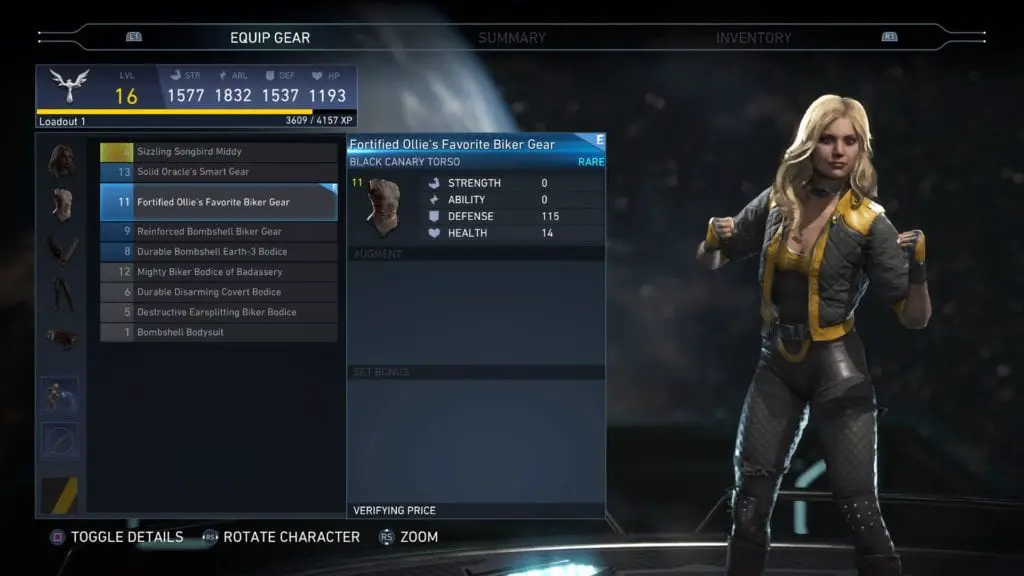
Back to the gear system itself. With the exception of shaders and premier skins, the pieces you choose also change how your character plays by adding in stat bonuses and special abilities depending on your loadout. And this mechanic does work; it’s really fun to use! Unfortunately, almost all of the gear is locked behind a “loot box” system. That is to say, you get one of many different levels of treasure chest (called Mother Boxes, obviously) with the contents decided by an algorithm. So even if you open a Diamond-level Mother Box, there’s no guarantee that you’ll get a good piece of equipment for your favorite character. Hell, there’s no guarantee you’ll get any good gear.
You can get Mother Boxes by playing through the story mode, the Multiverse challenge mode (which is a ton of fun), and plenty of other ways…but the game does really seem to want you to buy more via microtransactions, which is, again, unfortunate. While nothing is locked behind a paywall, and no piece of gear requires you to pay any extra amount of real money than you did for the game…there’s no denying that trying to fill out an epic set of gear for your favorite character is going to be a lot more time consuming otherwise. On the other hand, NetherRealm did something extremely smart with how the gear system worked on a cosmetic level: if you like the look of an item, but the stats aren’t what you want, you can basically apply stats of a better piece of gear…and that’s it. No more frustration that the coolest looking armor has crappy stat bonuses!
As I don’t have Playstation Plus, I can’t tell you how the online component panned out…but I can say with absolute certainty that I would have gotten my butt handed to me in maybe thirty seconds regardless of how well the netcode held up. So neither here nor there. Aside from that, there’s also the Multiverse mode, which allows you to play through a massive number of combat scenarios that refresh rather often depending on the size, difficulty and complexity of the challenges. One Alternate Earth may be available for only two hours (though as long as you don’t quit, you can keep playing it even if you put the game in Suspended Mode) while a different one could be open for sixty hours. If I didn’t have things to do, I could see myself getting sucked into this for…like, a really, really long time. Let’s just say that Injustice 2 has quite a bit of staying power over me.
Before we get to the score, I had a few extra thoughts on the narrative, some of it pertaining to the Harely/Ivy relationship. Regarding that…while it is unfortunate to see Pamela fighting Harely—who really just wants them to get back together “like the old days”—I think a big part of this outrage by the fandom is that a lot of people tend to forget just how focused Poison Ivy gets on her eco-terrorism. The vast majority of the time, even in the current Harely Quinn comic, she just up and leaves Harely the second her job comes up and can’t commit to moving in with her because she’s gotta go save the planet.
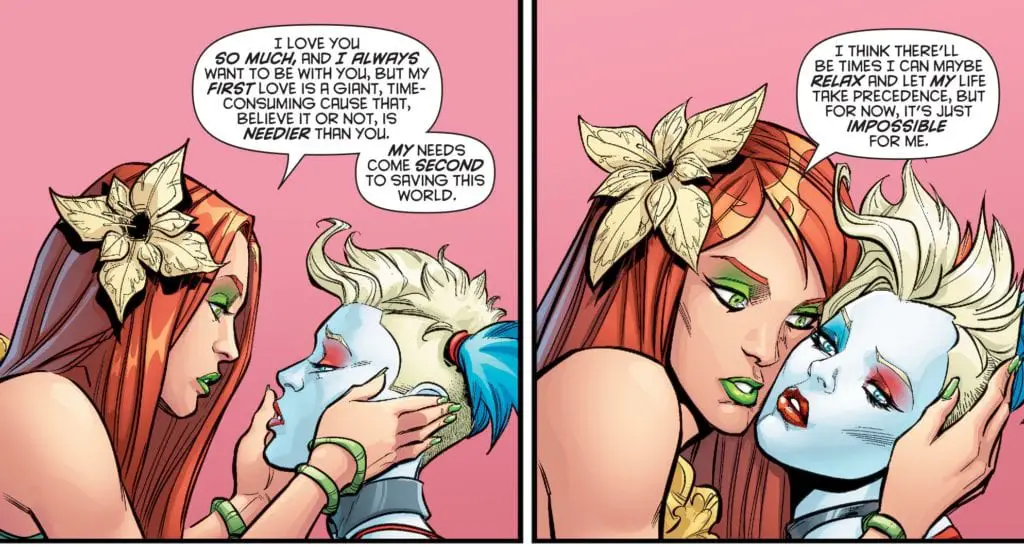
At the end of the day, while Pam comes first for Harely…Harley doesn’t come first for Pam in the main DCU. Yes, they are both pansexual women in a polyamorous relationship in the comics, and that—aside from the relationship part—seems to be the case here as well (Ivy’s banter mentions that good ol’ mind control kiss regardless of her opponent’s gender, and there’s even a combo for it). But this isn’t DC Bombshells. Poison Ivy is still a supervillain here (on her best day, she’s an anti-hero/well-intentioned extremist in the DCU) and Harely is reformed. It would have been nice for them to be a happy couple in the game, but it wouldn’t have made a lot of narrative sense. Unlike Ollie and Dinah, who were both “dead”—look that one’s complicated. Blame Doctor Fate.
Oh, and also Batwoman didn’t return from her definitely-probably-presumed-dead-but-actually-bouncing-around-alternate-earths jaunt…or perhaps she did? Apparently there’s a President Kane in Batman’s character-specific ending cinematic that asks him to lead the recovery efforts after they stop Brainiac, but that could be Jacob. It could also be, in a rather clever reference to the DC Animated film Crisis on Two Earths, where Slade Wilson, aka Deathstroke, was President and the evil versions of the Justice League ruled the planet, Adeline Kane. The ex-wife of Slade Wilson. But that seems like a stretch. Regardless, I wish she was in the game in some form. Maybe as a premiere skin for Batman? Eh? Okay, I’ll stop.


